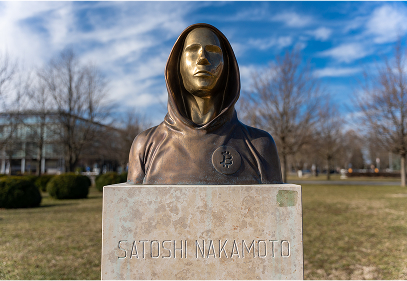Who Created Bitcoin: The Mystery Behind Satoshi Nakamoto
In 2009, a revolutionary digital currency emerged that would forever change how we think about money and financial systems. Behind this groundbreaking innovation stands one of technology’s greatest mysteries: Satoshi Nakamoto’s identity as Bitcoin’s creator. While we know the name associated with Bitcoin’s creation, the person or group behind it remains hidden behind a pseudonym that has captivated the crypto community and beyond for over 15 years.
The question of who created Bitcoins leads us directly to Satoshi Nakamoto, a name that has become synonymous with innovation, mystery, and the birth of cryptocurrency itself. Despite Bitcoin’s massive success and global adoption, Bitcoin’s founder Nakamoto’s identity remains one of the most enduring puzzles in modern technology and finance.
The Creator of Bitcoin: Satoshi Nakamoto
Bitcoin was created by an individual or group using the pseudonym Satoshi Nakamoto, whose true identity remains unknown despite extensive investigation by journalists, researchers, and government agencies. This mysterious figure, often referred to as the Bitcoin inventor, fundamentally changed the financial landscape by solving the double spending problem that had plagued previous attempts at creating decentralized digital currency.
Nakamoto published the groundbreaking Bitcoin white paper titled “Bitcoin: A Peer-to-Peer Electronic Cash System” on October 31, 2008, distributing it through The Cryptography Mailing List. This document outlined a revolutionary approach to creating a peer electronic cash system that would operate without requiring a central authority like traditional banks.
The first Bitcoin software was released on January 3, 2009, officially launching the Bitcoin network with the creation of the Genesis Block. This inaugural block contained a now-famous message: “The Times January 3, 2009 Chancellor on brink of second bailout for banks,” directly referencing the ongoing financial crisis and highlighting Bitcoin’s purpose as an alternative to traditional banking systems.
Nakamoto’s creation represented the world’s first successful implementation of blockchain technology, establishing the foundation for thousands of cryptocurrencies that would follow. The Bitcoin blockchain demonstrated that a decentralized network could maintain consensus without central banks or government oversight, proving that digital transactions could occur directly between users.
Despite creating what would become a trillion-dollar asset class, Nakamoto’s true identity remains unknown. This anonymity wasn’t accidental – it appears to have been a deliberate choice to protect both the creator and the integrity of the decentralized system they had built.
The Development Timeline of Bitcoin
Understanding who created Bitcoins requires examining the careful progression from concept to reality. The development timeline reveals a methodical approach that suggests significant planning and technical expertise.
Early Development (2007-2008) Bitcoin software development likely began in early 2007, though the earliest public evidence appeared in August 2008 when the Bitcoin.org domain was registered. This registration used anonymous hosting services, maintaining the creator’s commitment to privacy from the very beginning.
The Whitepaper Publication (October 31, 2008) On Halloween 2008, Nakamoto published the Bitcoin whitepaper on a cryptography mailing list, introducing the concept to a small group of cryptography experts and digital privacy enthusiasts. Only a handful of people initially engaged with the revolutionary ideas presented in the document.
Network Launch (January 3, 2009) The Bitcoin network officially launched when Nakamoto mined the Genesis Block, containing the first Bitcoins ever created. This first blockchain block established the foundation for all future Bitcoin transactions and demonstrated the practical implementation of the whitepaper’s theoretical framework.
First Transaction (January 12, 2009) Nine days after launch, the first Bitcoin transaction occurred when Nakamoto sent 10 BTC to computer engineer Hal Finney. This first transaction proved the system worked as intended and marked the beginning of Bitcoin’s journey from experimental software to functional digital currency.
Active Development Period (2009-2010) During this period, Nakamoto actively developed Bitcoin and communicated with early adopters, continuously improving the Bitcoin software and addressing technical challenges. The developer maintained regular correspondence with the growing Bitcoin community, providing guidance and implementing crucial updates.
Final Communication (April 2011) Nakamoto’s final known communication occurred in April 2011, when they handed control of the project to developer Gavin Andresen and stated they were “moving on to other things.” This strategic withdrawal marked the end of direct involvement from Bitcoin’s creator.
What We Know About Satoshi Nakamoto
Despite extensive investigation, concrete information about who created Bitcoins remains limited. However, analysis of Nakamoto’s communications and behavior patterns provides several clues about their background and motivations, even as they choose to remain anonymous .
Communication Patterns and Language Nakamoto demonstrated native-level English writing skills with notably British spelling patterns, using terms like “bloody hard” and “colour” instead of “color.” These linguistic choices suggest either British origins or deliberate misdirection by someone familiar with British English conventions.
Technical Expertise The anonymous creator showed a deep understanding of cryptography, computer science, and economics. Their knowledge spanned multiple disciplines, suggesting either extensive self-education or formal training in these fields. The Bitcoin software’s sophisticated implementation of cryptographic principles demonstrates mastery of complex mathematical concepts.
Geographic and Temporal Clues Posts from Nakamoto occurred at times inconsistent with a Japanese timezone, despite claiming to be a 37-year-old Japanese man. Communication patterns suggested someone operating in either American or European time zones, contradicting the stated Japanese location.
Philosophical Motivations Nakamoto expressed libertarian views and strong criticism of traditional banking systems throughout their communications, which have implications for trading practice . The Genesis Block’s embedded message about bank bailouts clearly demonstrated their motivation to create an alternative to centralized financial control.
Privacy Commitment From the beginning, Nakamoto used anonymous hosting services, private email accounts, and other privacy-protecting measures. This commitment to anonymity suggests either prior experience with privacy technology or significant concern about potential legal or personal consequences.
The pseudonym Satoshi Nakamoto itself may contain intentional symbolism. In Japanese, “Satoshi” can mean “wise” or “clear-thinking,” while “Nakamoto” could translate to “central origin,” potentially hinting at Bitcoin’s role as the central origin of cryptocurrency innovation.
Nakamoto’s Bitcoin Holdings and Wealth
One of the most intriguing aspects of the question “who created Bitcoins” involves the massive wealth that Nakamoto accumulated but never touched. Analysis of early mining patterns suggests the Bitcoin inventor controls approximately 1 million Bitcoins from the earliest days of the network.
The Genesis Block Holdings The Genesis Block itself contains 50 Bitcoins that remain unspent to this day. Interestingly, Bitcoin community members continue sending small donations to this address, treating it as a shrine to Bitcoin’s origins. These coins, along with many others from early blocks, have never moved.
Estimated Total Holdings Researchers estimate that Nakamoto controls around 1 million Bitcoins based on analysis of early mining patterns and wallet behaviors. At current market prices, with Bitcoin’s price exceeding $120,000, this hoard would be valued at over $120 billion, making the unknown creator one of the world’s wealthiest individuals.
Untouched Wealth Perhaps most remarkably, no Bitcoins from Nakamoto’s known wallets have been moved since 2009. This restraint demonstrates either incredible discipline or suggests the private keys may be lost or the creator may be deceased. The untouched holdings are often seen as evidence of commitment to Bitcoin’s success over personal profit.
Market Impact The dormant nature of these holdings provides both stability and uncertainty to the Bitcoin market. While their continued inactivity suggests they won’t suddenly flood the market, any movement from these addresses would likely cause significant price volatility and intense speculation about Nakamoto’s return.
The substantial wealth that remains untouched serves as a powerful symbol of Bitcoin’s founding principles. Unlike traditional founders who typically monetize their creations by finding ways to sell Bitcoin , Nakamoto’s approach reinforces the decentralized nature of the system they created.
Leading Theories About Nakamoto’s Identity
The mystery of who created Bitcoins has spawned numerous theories and investigations. While multiple candidates have been proposed, none have been conclusively proven, and the Bitcoin community generally accepts that cryptographic proof or movement of early Bitcoins would be required for definitive identification.
The criteria for potential identification remain clear: any legitimate claimant would need to either move Bitcoins from known Nakamoto addresses or provide cryptographic proof of identity using private keys associated with early Bitcoin development.
Prominent Candidates
Nick Szabo Cryptographer Nick Szabo created Bit Gold, a precursor to Bitcoin that shares many similar concepts. Linguistic analysis has identified similarities between Szabo’s writing style and Nakamoto’s communications. Szabo consistently denies being Nakamoto, but his deep involvement in cryptocurrency development before Bitcoin’s creation makes him a compelling candidate for who invented Bitcoin.
Hal Finney Computer engineer Hal Finney received the first Bitcoin transaction and was heavily involved in early Bitcoin development. Finney lived near Dorian Nakamoto (discussed below), which some theorists suggest was intentional misdirection. His background in cryptography and early adoption of Bitcoin technology position him as a strong candidate, though he denied being Nakamoto before his death in 2014.
Craig Wright Australian academic Craig Wright has repeatedly claimed to be Satoshi Nakamoto, even pursuing legal action to support his claims. However, courts have consistently rejected his evidence, and the crypto community widely disputes his assertions. Wright’s inability to provide cryptographic proof or move early Bitcoins undermines his credibility as Bitcoin’s creator.
Dorian Nakamoto In 2014, Newsweek magazine incorrectly identified Dorian Nakamoto, a Japanese-American engineer, as Bitcoin’s creator based on his name and technical background. Dorian denied involvement with Bitcoin and demonstrated little knowledge of cryptocurrency. This misidentification highlighted the dangers of speculation about Nakamoto’s identity.
Len Sassaman Privacy advocate and cryptographer Len Sassaman worked on anonymous communication systems and had connections to many early Bitcoin contributors. His suicide in 2011, shortly after Nakamoto’s disappearance, has led some to speculate about connections. However, no concrete evidence links Sassaman to Bitcoin’s creation.
Dave Kleiman Computer forensics expert Dave Kleiman had the technical skills necessary for Bitcoin development and died in 2013. Some theories suggest collaboration between Kleiman and Craig Wright, though these claims remain unsubstantiated. Kleiman’s background in computer security and cryptography make him a plausible candidate for involvement in Bitcoin’s early development.
Each potential candidate brings compelling evidence, but none have provided the definitive proof required to solve the mystery of who created Bitcoins.
Nakamoto’s Disappearance from Bitcoin
The strategic withdrawal of Bitcoin’s creator represents one of the most significant acts of leadership in technology history. Rather than maintaining control, satoshi nakamoto’s anonymity became a deliberate choice to ensure Bitcoin’s decentralized nature.
Gradual Reduction in Involvement Starting in 2010, Nakamoto gradually reduced their direct involvement in Bitcoin development. They began delegating responsibilities to other developers and contributing less frequently to technical discussions. This transition period allowed the Bitcoin community to adapt to distributed leadership.
Handover to Gavin Andresen In April 2011, Nakamoto officially handed control of the Bitcoin project to developer Gavin Andresen, providing him with administrative access and project leadership responsibilities. This transfer marked a crucial moment in Bitcoin’s evolution from single-creator project to community-driven development.
Final Communication Nakamoto’s final email simply stated they were “moving on to other things,” providing no indication of future plans or identity. This cryptic farewell maintained the mystery while clearly signaling the end of their direct involvement in Bitcoin development.
Strategic Decentralization The disappearance wasn’t random – it appears to have been a calculated decision to prevent Bitcoin from having a central point of failure. By removing themselves from the project, Nakamoto ensured that no single individual could control or compromise the Bitcoin network.
Impact on Credibility Rather than harming Bitcoin’s prospects, Nakamoto’s disappearance actually enhanced the cryptocurrency’s credibility. The absence of a controlling founder demonstrated Bitcoin’s resilience and proved that the decentralized system could function independently of its creator.
This voluntary abdication of control over a potentially world-changing technology remains unprecedented in the tech industry, where founders typically maintain significant influence over their creations.
The Legacy and Impact of Bitcoin’s Anonymous Creator
The mystery of who created Bitcoins extends far beyond simple curiosity – it has fundamentally shaped cryptocurrency culture and the broader adoption of blockchain technology.
Proving Decentralized Governance Bitcoin’s continued success without central leadership demonstrates that decentralized governance can work effectively. The network has processed millions of transactions, survived numerous technical challenges, and achieved global adoption without requiring direction from its original creator.
Protection from Pressure Nakamoto’s anonymity protects Bitcoin from government pressure and personal attacks that might target a known founder. This protection has allowed Bitcoin to develop independently of political influence and has prevented authorities from pressuring the creators or miners to modify or restrict the system.
Inspiration for Innovation The success of Bitcoin inspired the creation of thousands of other cryptocurrencies, spawning an entire industry worth trillions of dollars. Each new project builds upon the foundation established by Nakamoto’s original innovation, extending the impact far beyond the initial Bitcoin software.
Revolutionary Financial Impact Bitcoin has fundamentally altered how we think about money, challenging traditional banking systems and central banks worldwide. The peer electronic cash system has enabled financial inclusion for unbanked populations and provided an alternative store of value during economic uncertainty.
Cultural Significance The mystery itself has become part of Bitcoin’s cultural appeal. The unknown creator has achieved mythical status in the crypto community, inspiring artwork, literature, and ongoing speculation. In Budapest, a bronze bust commemorates Nakamoto, reflecting the cultural impact of this anonymous innovation.
Ongoing Development Bitcoin development continues through a distributed network of contributors, proving that open-source projects can thrive without centralized control. The Satoshi Nakamoto Institute preserves and promotes the philosophical foundations established by Bitcoin’s creator.
The question of who created Bitcoins may never be answered definitively, but the impact of their creation continues to reshape global finance and technology. Whether Nakamoto was an individual genius or a collaborative group, their vision of decentralized currency has proven both revolutionary and enduring.
The legacy demonstrates that sometimes the most powerful innovations come from those willing to work in the shadows, prioritizing the success of their creation over personal recognition or wealth. In an age of celebrity founders and personal brands, Nakamoto’s approach offers a compelling alternative model for technological innovation.
As Bitcoin continues to evolve and gain mainstream acceptance, the mystery of its creator serves as a reminder that revolutionary change can emerge from unexpected sources. The pseudonym Satoshi Nakamoto represents not just an individual, but an idea – that financial freedom, supported by computational power, and technological progress don’t require traditional authority or recognition.
Whether we ever learn who created Bitcoins or not, their anonymous contribution has already secured a permanent place in history as one of the most significant innovations of the digital age.



